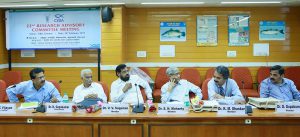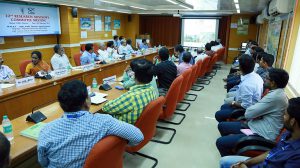The 22nd Research Advisory Committee (RAC) meeting of ICAR-CIBA was organised on 20th Feb 2017, in its headquarters at Chennai, with the participation of ICAR nominated RAC members under the chairmanship of Dr K. Gopakumar, Former Deputy Director General (DDG_Fisheries). Distinguished ICAR nominated members such as Dr. V. V. Sugunan, Former ADG (Fisheries), Dr. K. M. Shankar, former Dean, Karnataka Veterinary, Animal and Fisheries Sciences University, Dr. G. Gopakumar, Emeritus Scientist, CMFRI, Dr. S. N. Mohanty, former head , ICAR-CIFA, Dr. Pravin Puthra, ADG (Marine Fisheries) were also attended the meeting. Dr K. K. Vijayan, the Director, ICAR-CIBA welcomed the Chairman and the members, followed by, the chairman and members briefed their remarks. Subsequently, Dr K. K. Vijayan, Director, ICAR -CIBA explained the salient achievements, new initiatives, and ongoing research program of CIBA. The Action taken the report of the last RAC recommendations was presented by Dr M. Jayanthi, Member Secretary. Detailed presentations on research achievements of 2016-17 and the proposed programmes for 2017-18 were made by the Heads and In-charges of the divisions. The research findings were discussed in detail with a focus on scientific contributions and its transformation to benefit the stakeholders of brackishwater aquaculture.
The Chairman and Members complimented the progress of research at the institute, especially the holistic approach of CIBA in supporting the brackishwater aquaculture by doing R&D activities in diversified areas. They valued CIBA’s foothold in seed and feed production technologies, species diversification, surveillance of aquatic animal disease, diversification of rearing system etc. CIBA’s efforts on demonstration of Indian white shrimp farming as alternate for exotic pacific shrimp vannamei, mapping of suitable resources for brackishwater aquaculture, mass seed production of seabass, cost-effective indigenous feed technology (Vannamei plus), molecular genetic studies (whole mitochondrial genome of Penaeus indicus), demonstration of nursery rearing of finfish species, integrated multitrophic aquaculture (IMTA) in brackish water, disease diagnostic protocols, soil health card etc. were recognized as important output for the sector. They also suggested to have many partnership farming programmes with farmers, and stressed the need for CIBA’s support in the widely practised vannamei farming in India; for example, fine tuning the biofloc technology to our Indian soil, precise feed management and sourcing of quality seeds.
Chairman in his concluding remarks advised standardisation of milkfish seed production and continuation of efforts to breed grey mullet. He also stressed optimization of cost-effective seabass feed on par with the imported international feed brands. Members suggested focussing on increasing the visibility and presence of CIBA in the sector on the national level. They also stressed to concentrate on the commercialisation of various technologies developed by CIBA and focused research on what exactly the sector needs with a futuristic vision. More emphasis was given on research areas such as cost-effective technologies on feed and seed production, adoption of BMP’s, sea ranching of hilsa seeds, mapping of potential areas for brackishwater aquaculture farming and farming models to bring down the cost of production of the final product. Finally, the director, ICAR-CIBA briefed the challenges in terms of resources like finance, manpower and physical space, and invited the committee to offer their generous help in sourcing external research funding. Earlier in the afternoon session, the Chairman of RAC, Dr. K. Gopakumar, released the 22 minutes long ICAR-CIBA’s profile video which explains entire CIBA and its activities vividly. This effort was highly appreciated and suggested to be broadcasted in mass media to sensitize the rural farmers and other stakeholders on the research programmes and findings of ICAR-CIBA. In the end, Dr M. Jayanthi, Member secretary proposed the vote of thanks to all the members of the RAC for their effort in joining the meeting and their valuable recommendations for structuring the upcoming research projects.


